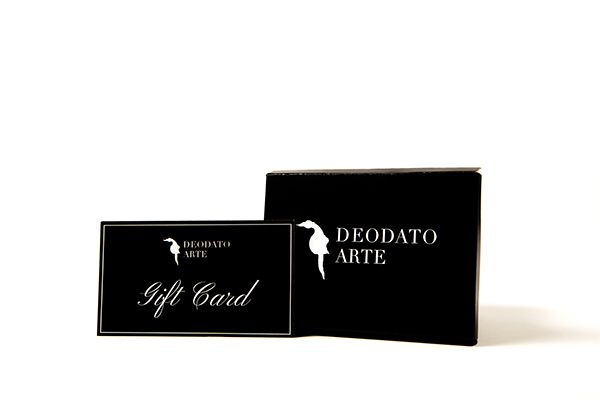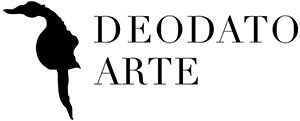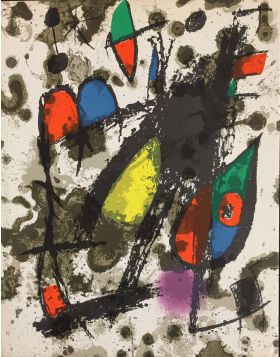
Thank you!

Joan Miró

Joan Miró: Art for Sale on Deodato Arte - Born in Barcelona in 1893, Joan Miró was one of the major exponents of Surrealism. His artworks are characterized by bright colours, fluid shapes and floating objects. Due to his meeting with Pablo Picasso, his art was also influenced by Cubism.
Abstract shapes and references to childhood and fantasy allow Joan Miró to create a very personal expressive vocabulary.
-
Untitled
Joan Mirò£575.14 VAT Margin (art. 36)VAT included
Products with VAT included show a price calculated with VAT tax, so the additional tax of 22% is already added to the price of these products.
VAT Margin
The products with VAT Margin apply the additional tax of 22% only on the margin, the difference between the price at which the product is purchased and the price at which the same product is resold.
28 cm x 38 cm
-
Untitled
Joan Mirò£575.14 VAT Margin (art. 36)VAT included
Products with VAT included show a price calculated with VAT tax, so the additional tax of 22% is already added to the price of these products.
VAT Margin
The products with VAT Margin apply the additional tax of 22% only on the margin, the difference between the price at which the product is purchased and the price at which the same product is resold.
28 cm x 38 cm
-
Untitle
Joan Mirò£575.14 VAT Margin (art. 36)VAT included
Products with VAT included show a price calculated with VAT tax, so the additional tax of 22% is already added to the price of these products.
VAT Margin
The products with VAT Margin apply the additional tax of 22% only on the margin, the difference between the price at which the product is purchased and the price at which the same product is resold.
24.5 cm x 32 cm
-
Untitled
Joan Mirò£408.43 VAT Margin (art. 36)VAT included
Products with VAT included show a price calculated with VAT tax, so the additional tax of 22% is already added to the price of these products.
VAT Margin
The products with VAT Margin apply the additional tax of 22% only on the margin, the difference between the price at which the product is purchased and the price at which the same product is resold.
25 cm x 32 cm
-
Untitled
Joan Mirò£408.43 VAT Margin (art. 36)VAT included
Products with VAT included show a price calculated with VAT tax, so the additional tax of 22% is already added to the price of these products.
VAT Margin
The products with VAT Margin apply the additional tax of 22% only on the margin, the difference between the price at which the product is purchased and the price at which the same product is resold.
24.5 cm x 32 cm
-
Untitled
Joan Mirò£741.84 VAT Margin (art. 36)VAT included
Products with VAT included show a price calculated with VAT tax, so the additional tax of 22% is already added to the price of these products.
VAT Margin
The products with VAT Margin apply the additional tax of 22% only on the margin, the difference between the price at which the product is purchased and the price at which the same product is resold.
55,5 cm x 38 cm
-
Untitled
Joan Mirò£825.19 VAT Margin (art. 36)VAT included
Products with VAT included show a price calculated with VAT tax, so the additional tax of 22% is already added to the price of these products.
VAT Margin
The products with VAT Margin apply the additional tax of 22% only on the margin, the difference between the price at which the product is purchased and the price at which the same product is resold.
49,5 cm x 32 cm
-
Untitled
Joan Mirò£825.19 VAT Margin (art. 36)VAT included
Products with VAT included show a price calculated with VAT tax, so the additional tax of 22% is already added to the price of these products.
VAT Margin
The products with VAT Margin apply the additional tax of 22% only on the margin, the difference between the price at which the product is purchased and the price at which the same product is resold.
49,5 cm x 32 cm
-
Untitled
Joan Mirò£741.84 VAT Margin (art. 36)VAT included
Products with VAT included show a price calculated with VAT tax, so the additional tax of 22% is already added to the price of these products.
VAT Margin
The products with VAT Margin apply the additional tax of 22% only on the margin, the difference between the price at which the product is purchased and the price at which the same product is resold.
56 cm x 38 cm
-
Untitled
Joan Mirò£408.43 VAT Margin (art. 36)VAT included
Products with VAT included show a price calculated with VAT tax, so the additional tax of 22% is already added to the price of these products.
VAT Margin
The products with VAT Margin apply the additional tax of 22% only on the margin, the difference between the price at which the product is purchased and the price at which the same product is resold.
26 cm x 32 cm
-
Untitled
Joan Mirò£741.84 VAT Margin (art. 36)VAT included
Products with VAT included show a price calculated with VAT tax, so the additional tax of 22% is already added to the price of these products.
VAT Margin
The products with VAT Margin apply the additional tax of 22% only on the margin, the difference between the price at which the product is purchased and the price at which the same product is resold.
50 cm x 32 cm
-
Untitled
Joan Mirò£741.84 VAT Margin (art. 36)VAT included
Products with VAT included show a price calculated with VAT tax, so the additional tax of 22% is already added to the price of these products.
VAT Margin
The products with VAT Margin apply the additional tax of 22% only on the margin, the difference between the price at which the product is purchased and the price at which the same product is resold.
56 cm x 38 cm
-
Untitled
Joan Mirò£825.19 VAT Margin (art. 36)VAT included
Products with VAT included show a price calculated with VAT tax, so the additional tax of 22% is already added to the price of these products.
VAT Margin
The products with VAT Margin apply the additional tax of 22% only on the margin, the difference between the price at which the product is purchased and the price at which the same product is resold.
56 cm x 38 cm
-
Untitled
Joan Mirò£741.84 VAT Margin (art. 36)VAT included
Products with VAT included show a price calculated with VAT tax, so the additional tax of 22% is already added to the price of these products.
VAT Margin
The products with VAT Margin apply the additional tax of 22% only on the margin, the difference between the price at which the product is purchased and the price at which the same product is resold.
24,5 cm x 32 cm
-
Untitled
Joan Mirò£741.84 VAT Margin (art. 36)VAT included
Products with VAT included show a price calculated with VAT tax, so the additional tax of 22% is already added to the price of these products.
VAT Margin
The products with VAT Margin apply the additional tax of 22% only on the margin, the difference between the price at which the product is purchased and the price at which the same product is resold.
49,5 cm x 32 cm
-
Untitled
Joan Mirò£741.84 VAT Margin (art. 36)VAT included
Products with VAT included show a price calculated with VAT tax, so the additional tax of 22% is already added to the price of these products.
VAT Margin
The products with VAT Margin apply the additional tax of 22% only on the margin, the difference between the price at which the product is purchased and the price at which the same product is resold.
49,5 cm x 35 cm
-
Untitled
Joan Mirò£408.43 VAT Margin (art. 36)VAT included
Products with VAT included show a price calculated with VAT tax, so the additional tax of 22% is already added to the price of these products.
VAT Margin
The products with VAT Margin apply the additional tax of 22% only on the margin, the difference between the price at which the product is purchased and the price at which the same product is resold.
28,5 cm x 24 cm
-
Untitled
Joan Mirò£575.14 VAT Margin (art. 36)VAT included
Products with VAT included show a price calculated with VAT tax, so the additional tax of 22% is already added to the price of these products.
VAT Margin
The products with VAT Margin apply the additional tax of 22% only on the margin, the difference between the price at which the product is purchased and the price at which the same product is resold.
24,5 cm x 32 cm
-
Adonides 63
Joan Mirò£725.17 VAT Margin (art. 36)VAT included
Products with VAT included show a price calculated with VAT tax, so the additional tax of 22% is already added to the price of these products.
VAT Margin
The products with VAT Margin apply the additional tax of 22% only on the margin, the difference between the price at which the product is purchased and the price at which the same product is resold.
33 cm x 40 cm
-
Untitled
Joan Mirò£825.19 VAT Margin (art. 36)VAT included
Products with VAT included show a price calculated with VAT tax, so the additional tax of 22% is already added to the price of these products.
VAT Margin
The products with VAT Margin apply the additional tax of 22% only on the margin, the difference between the price at which the product is purchased and the price at which the same product is resold.
50 cm x 32 cm
-
Untitled
Joan Mirò£575.14 VAT Margin (art. 36)VAT included
Products with VAT included show a price calculated with VAT tax, so the additional tax of 22% is already added to the price of these products.
VAT Margin
The products with VAT Margin apply the additional tax of 22% only on the margin, the difference between the price at which the product is purchased and the price at which the same product is resold.
26 cm x 33 cm
-
Untitled
Joan Mirò£825.19 VAT Margin (art. 36)VAT included
Products with VAT included show a price calculated with VAT tax, so the additional tax of 22% is already added to the price of these products.
VAT Margin
The products with VAT Margin apply the additional tax of 22% only on the margin, the difference between the price at which the product is purchased and the price at which the same product is resold.
49,5 cm x 32 cm
-
Senza Titolo
Joan Mirò£575.14 VAT Margin (art. 36)VAT included
Products with VAT included show a price calculated with VAT tax, so the additional tax of 22% is already added to the price of these products.
VAT Margin
The products with VAT Margin apply the additional tax of 22% only on the margin, the difference between the price at which the product is purchased and the price at which the same product is resold.
25,5 cm x 32 cm
-
Untitled
Joan Mirò£408.43 VAT Margin (art. 36)VAT included
Products with VAT included show a price calculated with VAT tax, so the additional tax of 22% is already added to the price of these products.
VAT Margin
The products with VAT Margin apply the additional tax of 22% only on the margin, the difference between the price at which the product is purchased and the price at which the same product is resold.
32 cm x 24 cm
-
Untitled
Joan Mirò£316.74 VAT Margin (art. 36)VAT included
Products with VAT included show a price calculated with VAT tax, so the additional tax of 22% is already added to the price of these products.
VAT Margin
The products with VAT Margin apply the additional tax of 22% only on the margin, the difference between the price at which the product is purchased and the price at which the same product is resold.
24.5 cm x 32 cm
-
-
-
-
-
-
-
Senza Titolo
Joan Mirò£408.43 VAT Margin (art. 36)VAT included
Products with VAT included show a price calculated with VAT tax, so the additional tax of 22% is already added to the price of these products.
VAT Margin
The products with VAT Margin apply the additional tax of 22% only on the margin, the difference between the price at which the product is purchased and the price at which the same product is resold.
24,5 cm x 32 cm
-
Untitled
Joan Mirò£575.14 VAT Margin (art. 36)VAT included
Products with VAT included show a price calculated with VAT tax, so the additional tax of 22% is already added to the price of these products.
VAT Margin
The products with VAT Margin apply the additional tax of 22% only on the margin, the difference between the price at which the product is purchased and the price at which the same product is resold.
24,5 cm x 32 cm
-
Adonides 13
Joan Mirò£825.19 VAT Margin (art. 36)VAT included
Products with VAT included show a price calculated with VAT tax, so the additional tax of 22% is already added to the price of these products.
VAT Margin
The products with VAT Margin apply the additional tax of 22% only on the margin, the difference between the price at which the product is purchased and the price at which the same product is resold.
33 cm x 40 cm
-
Untitled
Joan Mirò£741.84 VAT Margin (art. 36)VAT included
Products with VAT included show a price calculated with VAT tax, so the additional tax of 22% is already added to the price of these products.
VAT Margin
The products with VAT Margin apply the additional tax of 22% only on the margin, the difference between the price at which the product is purchased and the price at which the same product is resold.
49,5 cm x 32 cm
-
Untitled
Joan Mirò£741.84 VAT Margin (art. 36)VAT included
Products with VAT included show a price calculated with VAT tax, so the additional tax of 22% is already added to the price of these products.
VAT Margin
The products with VAT Margin apply the additional tax of 22% only on the margin, the difference between the price at which the product is purchased and the price at which the same product is resold.
49,5 cm x 32 cm
-
Untitled
Joan Mirò£741.84 VAT Margin (art. 36)VAT included
Products with VAT included show a price calculated with VAT tax, so the additional tax of 22% is already added to the price of these products.
VAT Margin
The products with VAT Margin apply the additional tax of 22% only on the margin, the difference between the price at which the product is purchased and the price at which the same product is resold.
49,5 cm x 32 cm
-
Untitled
Joan Mirò£350.08 VAT Margin (art. 36)VAT included
Products with VAT included show a price calculated with VAT tax, so the additional tax of 22% is already added to the price of these products.
VAT Margin
The products with VAT Margin apply the additional tax of 22% only on the margin, the difference between the price at which the product is purchased and the price at which the same product is resold.
28 cm x 23,5 cm
-
-
-
-
Untitled
Joan Mirò£741.84 VAT Margin (art. 36)VAT included
Products with VAT included show a price calculated with VAT tax, so the additional tax of 22% is already added to the price of these products.
VAT Margin
The products with VAT Margin apply the additional tax of 22% only on the margin, the difference between the price at which the product is purchased and the price at which the same product is resold.
50 cm x 31.5 cm
-
Untitled
Joan Mirò£575.14 VAT Margin (art. 36)VAT included
Products with VAT included show a price calculated with VAT tax, so the additional tax of 22% is already added to the price of these products.
VAT Margin
The products with VAT Margin apply the additional tax of 22% only on the margin, the difference between the price at which the product is purchased and the price at which the same product is resold.
24,5 cm x 32 cm
-
Untitled
Joan Mirò£408.43 VAT Margin (art. 36)VAT included
Products with VAT included show a price calculated with VAT tax, so the additional tax of 22% is already added to the price of these products.
VAT Margin
The products with VAT Margin apply the additional tax of 22% only on the margin, the difference between the price at which the product is purchased and the price at which the same product is resold.
25 cm x 33 cm
-
Untitled
Joan Mirò£575.14 VAT Margin (art. 36)VAT included
Products with VAT included show a price calculated with VAT tax, so the additional tax of 22% is already added to the price of these products.
VAT Margin
The products with VAT Margin apply the additional tax of 22% only on the margin, the difference between the price at which the product is purchased and the price at which the same product is resold.
26 cm x 33 cm
-
Untitled
Joan Mirò£825.19 VAT Margin (art. 36)VAT included
Products with VAT included show a price calculated with VAT tax, so the additional tax of 22% is already added to the price of these products.
VAT Margin
The products with VAT Margin apply the additional tax of 22% only on the margin, the difference between the price at which the product is purchased and the price at which the same product is resold.
56 cm x 38 cm
-
Untitled
Joan Mirò£825.19 VAT Margin (art. 36)VAT included
Products with VAT included show a price calculated with VAT tax, so the additional tax of 22% is already added to the price of these products.
VAT Margin
The products with VAT Margin apply the additional tax of 22% only on the margin, the difference between the price at which the product is purchased and the price at which the same product is resold.
56 cm x 38 cm
Joan Miró: paintings and biography
Surrealist artist Joan Miró was a Spanish painter, ceramist and sculptor of the 20th century. The painter and critic André Breton described him as “the most Surrealist of us all”.
The first years of Joan Miró: life of a young talent
Joan Miró (1893-1983) was born from the marriage of a goldsmith and watchmaker, Miquel Miró Adzerias, to Dolores Ferrà of Oromi. Miró's first approach to drawing took place when he was only eight years old. Throughout his childhood and adolescence, he devoted himself to perfecting his artistic technique, in parallel with his business studies.
For the young Joan Miró, Barcelona was a springboard. Here he attended Galí Academy and Sant Lluc Artistic Circle, getting in touch with leading figures in the art world and discovering Fauvism.
Then he was later attracted by the community around Montparnasse. It was in Paris that Joan Miró met Picasso, one of the most famous painters and sculptors of the 20th century. The Dadaist circle of Tristan Tzara had also significant influence on Miró's art. Thanks to the contagious power of the poets and writers of Surrealism, Miró’s interest shifted to Abstract Art.
After his marriage with Pilar Juncosa in 1929, Joan Miró began his artistic experimentation, producing lithographs, etchings and sculptures, being introduced to painting on tar paper and glass, and to the Surrealist technique of grattage (the artist “scratched” freshly applied paint onto canvas or other support).
Among this period’s main works by Joan Miró, Harlequin's Carnival, The Farm and Peinture (Étoile bleue) are emblematic examples.
Joan Miró: The Farm
Painted between 1921 and 1922 in oil on canvas by Joan Miró, The Farm measures 123.8x141.3 cm.
The subject represented in the work by Joan Miró The Farm is one of the artist's childhood places. It is the family farm in Montroig del Camp, Catalonia. Signs of the Surrealist and Abstract influences are still absent. Instead, Miró's tendency to represent reality in a naïve style prevails.
Joan Miró: Harlequin's Carnival
Painted in oil on canvas between 1924 and 1925 by Joan Miró, Harlequin's Carnival measures 66x90.5 cm.
Despite preceding the publication of the Surrealist manifesto, in Harlequin's Carnival Miró scrupulously implemented its program, using psychic automatism, a technique that involved bodily efforts in order to stimulate fantastic and surreal visions. In Harlequin's Carnival, Joan Miró painted a large space with floating objects that narrate and invite us to take part in one of his visions.
Some references to the real world are recognizable: a black triangle representing the Eiffel Tower, a cat, a table, a ladder, a fish. But in Miró paintings, the real is transformed and reinvented, resulting in a new world that no longer responds - as in the earlier The Farm - to the visible world, but only to imagination.
The years of celebrity of Joan Miró: Surrealism and contempt for conventional painting
After having settled between Majorca and Montroig, Joan Miró increasingly embraced the current of André Breton, who described him as "the most surrealist of us all". In the writings of that time by Joan Miró, Surrealism and conventional painting are portrayed as two conflicting worlds.
In his first monograph, Joan Miró described his desire to "assassinate" conventional painting in order to create new means of expression. At the end of the 1940s, the artist began to work on loose ceramic pieces and bronze sculptures.
After a decade, Joan Miró had become an established artist: the prize for graphics at the Venice Biennale and the International Guggenheim Prize are among his greatest achievements. In 1972 the Fundació Joan Miró (Barcelona) was founded. Six years later, the artist created in the same city the sculpture Dona i ocell, now located in Joan Miró Park.
Works by Joan Miró such as Femme et oiseaux devant la lune, Dona en la nuit and Le Soleil rouge belong to this period.
Joan Miró: Femmes et oiseaux devant la lune
In the artwork by Joan Miró Femmes et oiseaux devant la lune, the theme of sexuality is linked to the one of night, described in a series of works Miró between 1942 and 1949. In Femmes et oiseaux devant la lune Miró enchants us with his childlike yet confident strokes.
In the work by Joan Miró Femmes et oiseaux, the simplification of forms is at its greatest. The figures appear as signs, floating between black patches and a few strong colours, in lively contrast with the background, whose ochre colour is highlighted by the rough canvas support.
The last years of Joan Miró
After the fall of Francoism, the artist was finally awarded in his homeland. A few examples are the honorary degree from the University of Barcelona and the Medalla d'Or from the Generalitat de Catalunya. Most of Joan Miró works date from this period: ceramics and paintings on glass engaged the artist during the 1980s.
In the last years of his life, Joan Miró style was influenced by his more radical ideas. The artist became interested in gaseous sculpture and four-dimensional painting. He died in Majorca at the age of 90.
Among the works from this phase of the career of Joan Miró, Constellations, Labyrinth and The Acid Melodies are emblematic examples.
Joan Miró: Constellations
The series by Joan Miró Constellations was completed in the last years of her life. It summarizes twenty years of the artist's life and research.
The series, consisting of 23 works, is a small-format cycle. Each work arose from an accident: the accidental cleaning of brushes on the support. In Constellations Miró described his controversial and visceral relationship with reality, conceived the surrounding world as a starting point for a journey to the stars.
André Breton described Miró Constellations as "superb paintings, from which a torrent of love and freedom flows". The large canvases, through plastic and sometimes aggressive colours, let Joan Miró's ideology emerge: art becomes a process of discovery.
Joan Miró paintings: for sale with prices and values on Deodato Arte
If you are interested in the artist, you can find Miró paintings for sale online on Deodato Arte website.
Do you want to know more about paintings by Joan Miró? Values and prices are available on our website. Miró paintings proposed by Contemporary Art Gallery Deodato Arte are carefully selected and provided with authentication certificate.
For any information about Miró paintings, please do not hesitate to contact us at [email protected].











 Register
Register Wishlist
Wishlist Contact Us
Contact Us













































